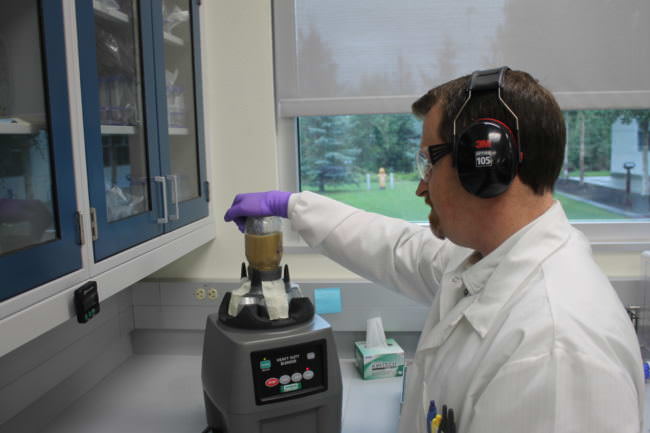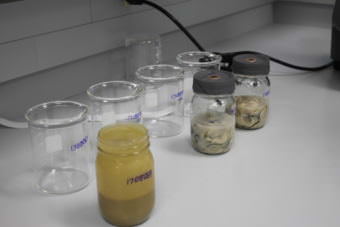
Places like Washington state have a long history of commercial oyster farming, and that means a long record of testing for deadly shellfish toxins. Alaska’s industry, by comparison, is relatively new. But that hasn’t stopped a growing number of people from becoming interested in cultivating oysters.
Alaskans are working together to try to make the industry safe and profitable. By tracking where paralytic shellfish poisoning occurs, more of the state’s seafood could make it to market.
Alaska’s shellfish producers have to go through rigorous testing routinely to make sure their product is safe to eat. When the weather is warm, they submit a sample to the state’s lab every week — sometimes more. That’s where Matthew Forester comes in.
Lots of people start their morning with a blended drink, but the mixture Forester is whipping up won’t become breakfast.
“We often describe it as making an oyster milkshake,” Forester said.
Forester tests commercial food for the Department of Environmental Conservation. Today he’s examining shellfish from three different farms.
After pulverizing the oysters to a beige mush, he boils the mixture with acid, which simulates digestion. When the mixture cools it gets spun around to separate the remaining oyster parts. What’s left goes into a tiny syringe.
“The testing consists of injecting three mice,” Forester said. “And then observing for death and time of death.”
Not all of the lab mice will die from paralytic shellfish poisoning. But on occasion, some do.
That’s when Forester has to send an email to the farmer — to let them know their mussels or oysters aren’t safe to eat.

“It feels bad. That’s the best way to put it. No one wants to deliver bad news,” Forester said. “But I also know many of the farmers don’t want to get bad news either. They would rather know and ensure the safety of their customers than not know.”
This summer, Forester had to deliver the bad news to five commercial oyster farms. That’s an uptick from last year. And some of those producers lost out on business for longer this summer than in previous years. It wound up costing one farmer over $30,000.
The toxin that causes paralytic shellfish poisoning is produced by harmful algal blooms. The algae can flourish in warm water. But Ginny Eckert, a fisheries professor at the University of Alaska Fairbanks, said right now that doesn’t appear to be the problem.
“The ocean this year, from what I’ve been hearing, was fairly close to normal,” Eckert said.
Still, Eckert said the harmful algae from previous warming could be taking a nap at the bottom of the ocean.
“So it can sort of get a build up of this resting phase in the sediments during these warm years that then persists in other years,” Eckert said.
But, Eckert stresses it’s not just one thing that causes the problem. It’s a combination of factors — a perfect storm. More freshwater from glacial melt is also thought to be changing the ocean.
Michael Jamros has a PhD in biochemistry and works with tribes to regularly monitor areas in Southeast Alaska for toxic shellfish. He said some years are just volatile.
“That’s what we’ve seen so far,” Jamros said.
He says this summer, the lab has documented high levels of paralytic shellfish poisoning, but it’s unclear what’s causing it. Alaska’s record of tracking this is still relatively young.
“It’s only been in the past decade or two where we’ve really been looking at it closely enough to really even be able to model this,” Jamros said.
That’s compared to nearly 80 years of testing in places like Washington state. But there are more coordinated efforts happening in Alaska. A new map will show where the toxin is cropping up all around the state.
Jamros thinks that’s the future of tracking paralytic shellfish poisoning.
“While we can’t predict it here, we’ve noticed certain beaches and certain areas seem to be very low in toxicity compared to other ones,” Jamros said. “So there are spots that are less prone to toxic blooms.”
By identifying those spots overtime, oyster farmers might have a better chance of routinely selling their product.




